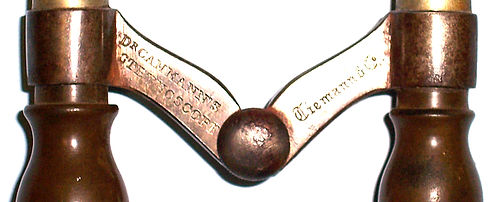Cammann stethoscopes




The Cammann stethoscope shown in the left photo dates to c. 1855. The left side of the yoke of the hinge joint is stamped Dr. Cammann's Stethoscope but is not hand engraved. The right side is stamped G. Tiemann & Co. The stethoscope is one piece, the short tubes are covered in velvet cloth and cannot be detached from the metal tubes. The ear pieces are ivory.
The right photo is a Cammann stethoscope, c. 1860. The left side of the yoke is marked Dr. Cammann's Stethoscope but is not hand engraved. The right side is marked Tiemann & Co. Note that the flexible tubes are longer, not covered in velvet and are attached by gutta percha connectors to the binaural ear tubes. The ear pieces are ivory. The two parts of the stethoscope could be detached for carrying and reattached for auscultation.
Cammann stethoscopes can be dated by the mark on their yoke. Prior to 1855 George Tiemann marked his medical instruments as Tiemann, in 1855 used the mark G. Tiemann & Co. and in 1860 used the mark Tiemann & Co.

Cammann models were designed with different types of tension mechanisms in order to hold the binaural ear pieces together so they would be firm against the auscultator's ears. The original tension mechanism designed by Dr. Cammann was an elastic band stretched between the two ear pieces as shown in the stethoscope above, marked W.F. Ford & Co, c. 1870.

Cammann stethoscope with clos ed spring adjustment mechanism, c. 1880

Cammann stethoscope with spring adjustment mechanism, Sharp & Smith, c. 1885

Geo. Tiemann & Co. Catalogue of Surgical Instruments, page 64, 1872 showing Camman's [sp] Stethoscope with a removable India Rubber Rim that allowed better contact with the chest wall. Also shown are Flint's Percussor and Flint's Hard Rubber Pleximeter.

Sharp & Smith Surgical Instruments Catalogue, page 524, 1889 showing the original Camman's [sp] Ordinary Stethoscope #2800, Camman's Stethoscope with closed spring adjustment #2801, Sharp & Smith's Improved spring adjustment Stethoscope #2802, and Knight's Improved (Camman's) Stethoscope #2803.

Cammann Stethoscope with simple bell made of hard rubber in its original cardboard box, c. 1895. The label reads Cammann Stethoscope, with elastic rubber band tension spring, Chas. Traux, Greene & Co., Chicago, Illinois.

Cammann stethoscope in its original tin case, c. 1870.

Cammann stethoscope, c. 1880, marked Dr. Cammann Stethoscope, Tiemann Co. The tooled leather case is marked Dr. John Hatton (1838-1898) who graduated the Iowa University Medical College in 1870 and practiced in Des Moines.


Cammann stethoscope with original band to hold ear pieces together and original mahogany case with label by Reynders & Co. , c. 1870

Davis modification of the Cammann Stethoscope which incorporated a wire metal tension spring between the metal ear tubes. In this early model, the wood chest bell was attached to the ear piece by a flexible tube which inserted into the wooden ball connecting the ear piece, c. 1880.

Later model Davis stethoscope with simple bell and metal tension mechanism between ear pieces, c. 1890 .


Matthews stethoscope with detachable chest piece and ear tubes for easy portability, c. 1882.
Unusal folding stethoscope with ivory earpieces and a unique bell that is a smaller version of the original Cammann bell with a insertable plug designed after the William's plug, c. 1890. This two piece bell is made of wood and allowed the auscultator to change the size of the bell by inserting or removing the plug.


Lynch's folding cammann stethoscope, c. 1880. This piece folds top to bottom as shown on the left.



Turn of the century Cammann stethoscope with small ebony bell marked Weiss, London c. 1901.
